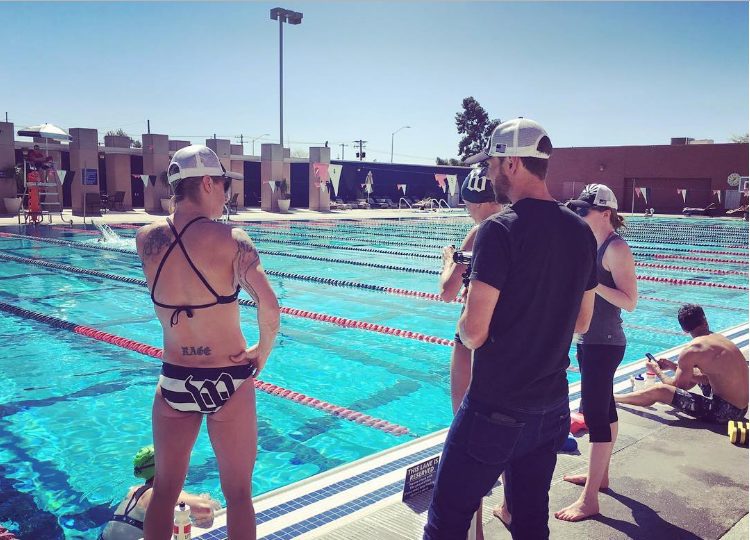Rachel McBride: How I went from average to front-of-pack swimmer
After completely switching up her program, McBride saw huge gains in her swimming and has tips for all athletes who want to achieve the same.

At Ironman Canada this year, Rachel McBride stunned spectators — and her swim coach, Gerry Rodrigues — when she pulled out a 51-minute swim across the 3.8-km distance and was first out of the water. As a previously fairly middle of the pack pro swimmer, McBride put has put in a ton of work over the past two years to improve her swim. But it hasn’t just been about more time in the water — she has attacked it with a completely new strategy, following Rodrigues’ Tower 26 program.
We interviewed McBride about her swimming progression and got insight into the keys to her success:
Can you tell us about your swimming background?
My parents tossed me in the pool just 4 months after I was born, and I really took to the water. At 11 I lost my passion for competitive swimming and moved on to other sports. When I started racing triathlons 17 years later, I trained with local masters and triathlon clubs. My typical times for a 1900m swim in a half iron have been around 26:30-27:30. At Great White North this July I swam 25:05. I don’t have a lot of experience with Ironman swimming only one race before this year: Ironman Cozumel, a non-wetsuit, downstream swim in just under 54 minutes, about 8 minutes down from the leaders. At Ironman Canada this year, I swam 51:12 coming out of the water first with a 2:30 lead.
How did you find Gerry’s program?
I found out about Tower 26 through social media when Gerry Rodrigues and Jim Lubinski started their Race Ready podcast in January 2016. Each episode had a workout of the day that I would copy down and do religiously. Gerry’s fundamentals on triathlon swimming and training really hit home with me. When they started their subscription service I was just at the point where I had decided doing 5:30am Masters swimming just wasn’t working for me anymore. I needed my sleep! So this spring I started doing all my swim training based on the Tower 26 workouts.
What part of the program has made the biggest difference in your training and what sets the program apart from others?
I think the biggest benefit of Gerry’s program is the skill building that is specific to triathlon racing, as well as the volume, frequency in the water. Mid-August I had already swum as many hours as I had all of last year. I’m consistently swimming 5000m workouts with big main sets and a lot of longer swimming than I was in my masters programs. I’m doing things that seem a bit silly like jumping out of the pool every 100m and doing jumping jacks on deck. Gerry is also big on mindfulness in the pool. Not only am I paying more attention to my stroke but pacing as well.
Can you describe your progression and when you started seeing real results from your training?
It really didn’t hit home that I had progressed so much until I raced Ironman Canada, my second race and first Ironman of the year. Until then I had just been grinding away at my workouts, putting in a lot of solid work. In long distance racing, I have been a middle of the pack swimmer. In my short career as a draft-legal ITU triathlete, I even came out of the water dead last at US Elite Nationals! Never have I led out of the water at an international-level race. So to come out of the water at IMC in first with a couple minutes lead was a huge accomplishment. Then to follow that up with another amazing swim at ITU Long Distance World Champs where I came out of the water with the lead pack of former ITU short course swimmers meant it was not just a fluke. In comparison, at 2016 ITU Worlds I excited the water 15 whole minutes behind the leaders on a 4000m, non-wetsuit swim. It’s challenging to compare times between races. The best comparison is look at the time you are typically coming out of the water behind the fastest swimmers. Keeping this in perspective, I really have made huge grounds in my swimming.
What’s your advice for triathletes looking to improve their swim?
I think the biggest thing to improve the swim is frequency in the water, as well as having a coach who can give you technique help. Especially if someone does not come from a swim background, it’s really hard to get a feel for the water by only swimming two to three times a week as a lot of triathletes do. I recognize it’s really hard to balance everything – training, family, work – but just a few more times in the water, even if it is just 30 minutes, can be a huge benefit. I also worked with a couple coaches for my technique this winter that made me more connected with my stroke and really changed my efficiency in the water. Even after a decade of working on technique, we still have a lot to learn!

